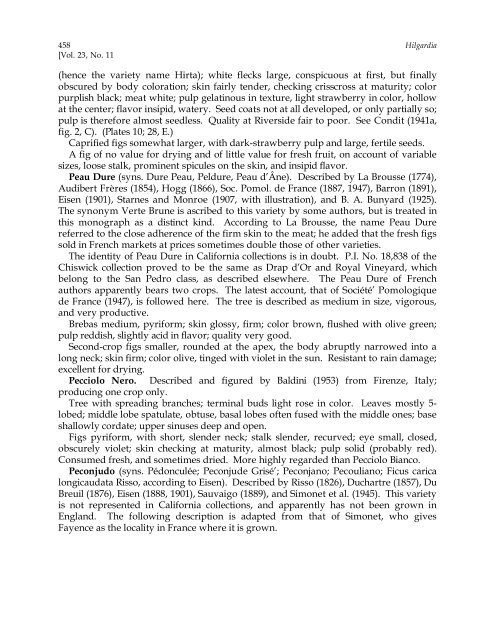Fig Varieties: A Monograph - uri=ucce.ucdavis
Fig Varieties: A Monograph - uri=ucce.ucdavis
Fig Varieties: A Monograph - uri=ucce.ucdavis
Create successful ePaper yourself
Turn your PDF publications into a flip-book with our unique Google optimized e-Paper software.
458 Hilgardia<br />
[Vol. 23, No. 11<br />
(hence the variety name Hirta); white flecks large, conspicuous at first, but finally<br />
obscured by body coloration; skin fairly tender, checking crisscross at maturity; color<br />
purplish black; meat white; pulp gelatinous in texture, light strawberry in color, hollow<br />
at the center; flavor insipid, watery. Seed coats not at all developed, or only partially so;<br />
pulp is therefore almost seedless. Quality at Riverside fair to poor. See Condit (1941a,<br />
fig. 2, C). (Plates 10; 28, E.)<br />
Caprified figs somewhat larger, with dark-strawberry pulp and large, fertile seeds.<br />
A fig of no value for drying and of little value for fresh fruit, on account of variable<br />
sizes, loose stalk, prominent spicules on the skin, and insipid flavor.<br />
Peau Dure (syns. Dure Peau, Peldure, Peau d’Âne). Described by La Brousse (1774),<br />
Audibert Frères (1854), Hogg (1866), Soc. Pomol. de France (1887, 1947), Barron (1891),<br />
Eisen (1901), Starnes and Monroe (1907, with illustration), and B. A. Bunyard (1925).<br />
The synonym Verte Brune is ascribed to this variety by some authors, but is treated in<br />
this monograph as a distinct kind. According to La Brousse, the name Peau Dure<br />
referred to the close adherence of the firm skin to the meat; he added that the fresh figs<br />
sold in French markets at prices sometimes double those of other varieties.<br />
The identity of Peau Dure in California collections is in doubt. P.I. No. 18,838 of the<br />
Chiswick collection proved to be the same as Drap d’Or and Royal Vineyard, which<br />
belong to the San Pedro class, as described elsewhere. The Peau Dure of French<br />
authors apparently bears two crops. The latest account, that of Société’ Pomologique<br />
de France (1947), is followed here. The tree is described as medium in size, vigorous,<br />
and very productive.<br />
Brebas medium, pyriform; skin glossy, firm; color brown, flushed with olive green;<br />
pulp reddish, slightly acid in flavor; quality very good.<br />
Second-crop figs smaller, rounded at the apex, the body abruptly narrowed into a<br />
long neck; skin firm; color olive, tinged with violet in the sun. Resistant to rain damage;<br />
excellent for drying.<br />
Pecciolo Nero. Described and figured by Baldini (1953) from Firenze, Italy;<br />
producing one crop only.<br />
Tree with spreading branches; terminal buds light rose in color. Leaves mostly 5-<br />
lobed; middle lobe spatulate, obtuse, basal lobes often fused with the middle ones; base<br />
shallowly cordate; upper sinuses deep and open.<br />
<strong>Fig</strong>s pyriform, with short, slender neck; stalk slender, recurved; eye small, closed,<br />
obscurely violet; skin checking at maturity, almost black; pulp solid (probably red).<br />
Consumed fresh, and sometimes dried. More highly regarded than Pecciolo Bianco.<br />
Peconjudo (syns. Pédonculée; Peconjude Grisé’; Peconjano; Pecouliano; Ficus carica<br />
longicaudata Risso, according to Eisen). Described by Risso (1826), Duchartre (1857), Du<br />
Breuil (1876), Eisen (1888, 1901), Sauvaigo (1889), and Simonet et al. (1945). This variety<br />
is not represented in California collections, and apparently has not been grown in<br />
England. The following description is adapted from that of Simonet, who gives<br />
Fayence as the locality in France where it is grown.















![Fig Trees in North Carolina [Archive] - IDigMyGarden ... - Figs 4 Fun](https://img.yumpu.com/26905320/1/190x245/fig-trees-in-north-carolina-archive-idigmygarden-figs-4-fun.jpg?quality=85)
